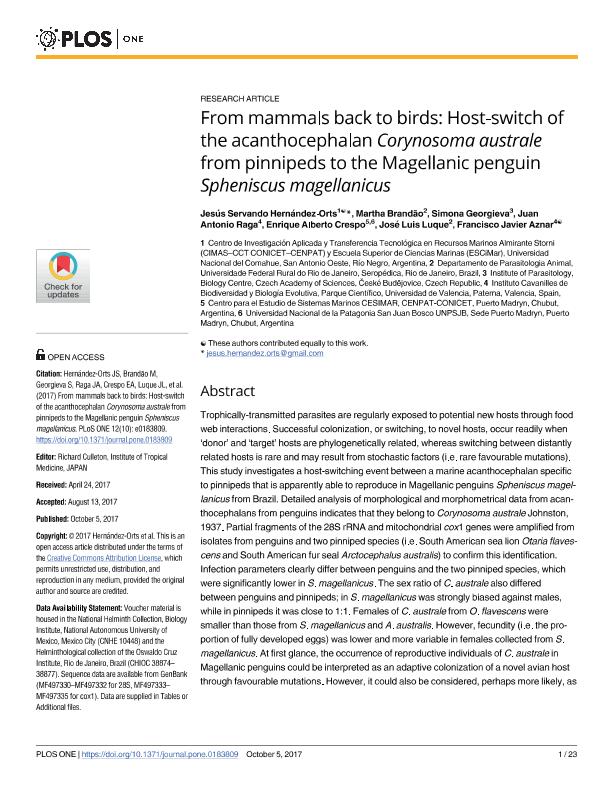Mostrar el registro sencillo del ítem
dc.contributor.author
Hernández Orts, Jesús Servando

dc.contributor.author
Brandão, Martha
dc.contributor.author
Georgieva, Simona
dc.contributor.author
Raga, Juan Antonio
dc.contributor.author
Crespo, Enrique Alberto

dc.contributor.author
Luque, José Luis
dc.contributor.author
Aznar Avendaño, Francisco Javier

dc.date.available
2018-05-02T18:04:16Z
dc.date.issued
2017-10
dc.identifier.citation
Hernández Orts, Jesús Servando; Brandão, Martha; Georgieva, Simona; Raga, Juan Antonio; Crespo, Enrique Alberto; et al.; From mammals back to birds: Host-switch of the acanthocephalan Corynosoma australe from pinnipeds to the Magellanic penguin Spheniscus magellanicus; Public Library of Science; Plos One; 12; 10; 10-2017; 1-23
dc.identifier.issn
1932-6203
dc.identifier.uri
http://hdl.handle.net/11336/43886
dc.description.abstract
Trophically-transmitted parasites are regularly exposed to potential new hosts through food web interactions. Successful colonization, or switching, to novel hosts, occur readily when ?donor? and ?target? hosts are phylogenetically related, whereas switching between distantly related hosts is rare and may result from stochastic factors (i.e. rare favourable mutations). This study investigates a host-switching event between a marine acanthocephalan specific to pinnipeds that is apparently able to reproduce in Magellanic penguins Spheniscus magellanicus from Brazil. Detailed analysis of morphological and morphometrical data from acanthocephalans from penguins indicates that they belong to Corynosoma australe Johnston, 1937. Partial fragments of the 28S rRNA and mitochondrial cox1 genes were amplified from isolates from penguins and two pinniped species (i.e. South American sea lion Otaria flavescens and South American fur seal Arctocephalus australis) to confirm this identification. Infection parameters clearly differ between penguins and the two pinniped species, which were significantly lower in S. magellanicus. The sex ratio of C. australe also differed between penguins and pinnipeds; in S. magellanicus was strongly biased against males, while in pinnipeds it was close to 1:1. Females of C. australe from O. flavescens were smaller than those from S. magellanicus and A. australis. However, fecundity (i.e. the proportion of fully developed eggs) was lower and more variable in females collected from S. magellanicus. At first glance, the occurrence of reproductive individuals of C. australe in Magellanic penguins could be interpreted as an adaptive colonization of a novel avian host through favourable mutations. However, it could also be considered, perhaps more likely, as an example of ecological fitting through the use of a plesimorphic (host) resource, since the ancestors of Corynosoma infected aquatic birds.
dc.format
application/pdf
dc.language.iso
eng
dc.publisher
Public Library of Science

dc.rights
info:eu-repo/semantics/openAccess
dc.rights.uri
https://creativecommons.org/licenses/by-nc-sa/2.5/ar/
dc.subject
Magellanic Penguin
dc.subject
Pinnipeds
dc.subject.classification
Otras Ciencias Biológicas

dc.subject.classification
Ciencias Biológicas

dc.subject.classification
CIENCIAS NATURALES Y EXACTAS

dc.title
From mammals back to birds: Host-switch of the acanthocephalan Corynosoma australe from pinnipeds to the Magellanic penguin Spheniscus magellanicus
dc.type
info:eu-repo/semantics/article
dc.type
info:ar-repo/semantics/artículo
dc.type
info:eu-repo/semantics/publishedVersion
dc.date.updated
2018-04-05T18:24:58Z
dc.journal.volume
12
dc.journal.number
10
dc.journal.pagination
1-23
dc.journal.pais
Estados Unidos

dc.journal.ciudad
San Francisco
dc.description.fil
Fil: Hernández Orts, Jesús Servando. Consejo Nacional de Investigaciones Científicas y Técnicas. Centro Científico Tecnológico Conicet - Centro Nacional Patagónico; Argentina. Universidad Nacional del Comahue. Centro de Investigacion Aplicada y Transferencia Tecnologica En Recursos Marinos "almirante Storni". - Provincia de Rio Negro. Ministerio de Agricultura, Ganaderia y Pesca. Centro de Investigacion Aplicada y Transferencia Tecnologica En Recursos Marinos "almirante Storni". - Consejo Nacional de Investigaciones Cientificas y Tecnicas. Centro Cientifico Tecnologico Conicet - Centro Nacional Patagonico. Centro de Investigacion Aplicada y Transferencia Tecnologica En Recursos Marinos "almirante Storni". ; Argentina; Argentina
dc.description.fil
Fil: Brandão, Martha. Universidade Federal do Rio de Janeiro; Brasil
dc.description.fil
Fil: Georgieva, Simona. Czech Academy of Sciences; República Checa
dc.description.fil
Fil: Raga, Juan Antonio. Universidad de Valencia; España
dc.description.fil
Fil: Crespo, Enrique Alberto. Consejo Nacional de Investigaciones Científicas y Técnicas. Centro Científico Tecnológico Conicet - Centro Nacional Patagónico. Centro para el Estudio de Sistemas Marinos; Argentina. Universidad Nacional de la Patagonia; Argentina
dc.description.fil
Fil: Luque, José Luis. Universidade Federal do Rio de Janeiro; Brasil
dc.description.fil
Fil: Aznar Avendaño, Francisco Javier. Universidad de Valencia; España
dc.journal.title
Plos One

dc.relation.alternativeid
info:eu-repo/semantics/altIdentifier/doi/http://dx.doi.org/10.1371/journal.pone.0183809
dc.relation.alternativeid
info:eu-repo/semantics/altIdentifier/url/http://journals.plos.org/plosone/article?id=10.1371/journal.pone.0183809
Archivos asociados
